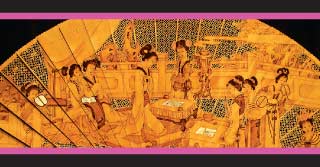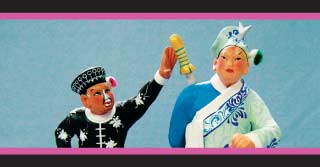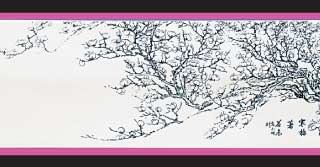|

SUZHOU CITY |
SUZHOU
EMBROIDERY
25
/ 08
~ 20 /
09
2009
Suzhou embroidery, or Su
embroidery for short, is ranked first among the “Four
Famous Embroideries” of China. It is the most
distinctive and well-known craft from Suzhou. A long
history of continuous development has given rise to a
comprehensive embroidery system divided into nine
categories and consisting of more than 40 stitches. The
styles known as “double-faced embroidery” and
“double-faced embroidery in three colours and designs”
are representative of the genre.
With over
20 years of embroidery experience, Cai is a National
Senior Craftswoman who has mastered the comprehensive
set of skills required for embroidering human figures,
flowers, animals and landscapes. Her works have won
numerous gold and silver awards in major competitions
and exhibitions such as the Masterpiece Expo of Chinese
Arts and Crafts. |
| |
|

SUZHOU CITY |
SANDALWOOD FANS
25 / 08 ~ 20 / 09
2009
The sandalwood fan evolved as a
natural development of the folding fan. The frame is made of sandalwood and
emits the characteristic pleasing odour when waved. Suzhou is the cradle of the
sandalwood fan, renowned for its delicate and elegant appearance featuring
landscapes with flower-and-bird motifs that require complex techniques including
cutting, pyrography, carving and drawing.
Chen Qin is an inheritor of this
Provincial Intangible Cultural Heritage craft. Since 1982, she has been engaged
in the design and production of a variety of fans at the Suzhou Sandalwood Fan
Factory. Over the years, her works have received numerous national and
provincial awards for excellence and have been included in the collections of
the Suzhou Arts and Crafts Museum. |
| |
|

SUZHOU CITY |
ENTALHE EM CAROÇO
22
/ 09
~ 18 / 10
2009
For Suzhou seed carving, an art
famous for its delicate craftsmanship, the olive pit is the material of choice.
Characterised by vivid motifs, a stereoscopic effect and fine craftsmanship,
seed carving possesses the unique charms of “precision, delicacy and elegance”.
This craft is also considered China’s representative form of miniature
sculpture.
Yin Yijun is a Suzhou folk artist
and master craftsman from Suzhou City. His works feature harmony between
traditional and modern aesthetics and have received numerous awards at the
Masterpiece Expo of Chinese Arts and Crafts. Among his most representative works
are Nine Sons of the Dragon and Facial Painting, both of which
combine the arts of painting, calligraphy and seal engraving. |
| |
|

SUZHOU CITY |
STONE CARVINGS
22 / 09 ~ 18 / 10
2009
Jinshan stone is a high-quality
carving material quarried in the mountainous Mudu Jinshan area of Western
Suzhou. The exquisite, age-old traditional art of Jinshan Stone Carving emerged
rapidly alongside development of this region's quarry industry.
Cai Jinxing studied inkstone
making and stone carving from an early age. He is currently a senior craftsman
and a representative inheritor of Provincial Intangible Cultural Heritage.
Skilled in the creation and repair of inkstones in the ancient style, he also
excels at carving Chengni sculptures and making Chengni clay kettles. His
endeavours have driven forward the development of stone carving in the region. |
| |
|

CHANGZHOU |
PENTES SHUE BI
20 / 10 ~ 15 / 11
2009
The combs of Changshou fall into
two categories. The shu is a wood comb used to comb the hair, while the bi is a
very finetoothed comb, serving to clean the hair of debris. Changzhou’ s shu and
bi combs are constructed of quality materials using highly demanding techniques.
For this reason they were once recognised as articles of tribute in the imperial
court, renowned as “imperial shu and famous bi”.
Qi Zhengkang is a representative
inheritor of Provincial Intangible Cultural Heritage. Successor to the fine
traditional craftsmanship of past generations, he has added modern elements to
his works which have earned him numerous awards. |
| |
|

CHANGZHOU |
ENTALHE EM BAMBU LIUQING
20 /
10 ~ 15
/ 11
2009
Changzhou’s liuqing technique for
bamboo carving has a long history and boasts remarkable achievements. Liuqing,
literally “retaining the green”, uses the green outer layer of the bamboo for
the design, removing the surrounding sections to expose a background of
underlying light-coloured fibres. In modern times a number of masters in liuqing
bamboo carving, based in Changzhou, have been producing many fine works.
A student of the great liuqing
master Bai Shifeng, Shao Fengfeng is currently a senior craftsman and has won
many awards in provincial and national arts and crafts competitions. His major
works include three sets of Art of War by Sun Zi composed of 13 chapters,
Orchid Pavilion and the Bodhidharma series. |
| |
|

WUXI CITY
|
WUXI EMBROIDERY
17
/ 11 ~
13 / 12
2009
Wuxi embroidery, known as Xi
embroidery for short, hails from Wuxi City, a major centre of Suzhou embroidery.
This superior traditional skill has developed an innovative technique known as
“double-faced miniature embroidery”, characterised by its small size, delicate
appearance and sophistication. Xi embroidery is more demanding of a
practitioner’s skills than normal double-faced embroidery.
As a master craftsman in Jiangsu,
Zhao Hongyu acquired the skills of embroidery from a veteran artist in Wuxi.
Zhao excels in the “double-faced fine miniature embroidery” unique to this art
form. She has won many gold and silver awards in provincial and national
competitions and exhibitions, and her hair embroidery work Landscape of the
Ancient Canal at Liangxi is listed in the Guinness Book of World Records. |
| |
|

WUXI CITY |
CLAY FIGURES FROM HUISHAN
17/ 11 ~
13 / 12
2009
Clay figures from Huishan, in
Wuxi, can be divided into two categories. The “coarse” figurines are
characterised by their simple, plain modelling and particularly favour themes of
joyfulness and auspiciousness. The “fine” figurines are made by hand and are
often fashioned as characters from traditional Chinese operas. The Huishan clay
figure’s complex craftsmanship features a set of skills known as the “eighteen
handmade techniques” and is acclaimed as one of the “Three Treasures of Wuxi”.
Zhou Lu studied the making of
Huishan clay figures from several masters including Yu Xianglian and Wang
Nanxian. Excelling in handmade clay figures, Zhou has received many awards in
provincial and national competitions and exhibitions and has several works in
the collections of provincial and national museums and art galleries in China,
Germany and France. |
| |
|

YANGZHOU CITY |
IVORY AND BAMBOO CARVINGS
15 / 12 ~ 10 / 01
2009
2010
The ivory and bamboo carving of
Yangzhou became prevalent in the Qing Dynasty (1644-1912), and through
successive generations of superior craftsmanship it gradually developed into a
unique art form. Imbued with the spirit of the literati and depicting diverse
themes, the craft is rich in Yangzhou flavour – being popular in both the
Yangtze and Huai river regions – and enjoys a worldwide reputation.
Fond of painting and calligraphy
since childhood, Gao Zhiming has accomplished much in calligraphy, painting and
seal engraving and has studied ivory carving since the age of 16. Having
mastered the traditional skills of Yangzhou ivory and bamboo carving, he also
specialises in the harmonious use of cutting and brushwork with a well-trained
eye for structure and aesthetics. |
| |
|

YANGZHOU CITY |
ARTISANAL GOLD AND SILVER CRAFT
15 / 12 ~ 10 / 01
2009
2010
The traditional gold and silver accessories and
handiwork from Jiangdu demand craftsmanship of high intelligence. Having
absorbed the traditional crucible melting method used to make gold and
silverware in China, together with the pattern engraving and glazing techniques
used to make Yangzhou bronze mirrors,
this craft produces gold and silver objects featuring a great variety of themes.
These craft items embody the great wisdom and hard work of generations of
artisans.
Influenced by the art of seal engraving since
childhood, Fang Xuebin has received the China Arts and Crafts Hundred Flowers
Award several times. He has been invited to participate in exhibitions in
Singapore and has enjoyed wide acclaim from both the media and his peers. |
| |
|

XUZHOU CITY |
CLOTH SCULPTURES
12 / 01 ~ 07 / 02
2010
Combining techniques from
painting, embroidery and sculpture, cloth sculpture is a reinvented art. It
produces a variety of rag dolls based on themes from human life and customs.
Evocative of childhood memories, the dolls are vivid and simple, boasting
delicate workmanship and widely popular bright coloration.
Known variously as the “Master of
Pengcheng”, “Queen of Dolls” and “Skilful Woman”, Wang Zhenxia is a
representative inheritor of Provincial Intangible Cultural Heritage. Her works
have garnered awards in national and provincial competitions and exhibitions,
and she has been invited to perform in both the United Kingdom and Germany. |
| |
|

XUZHOU CITY |
PERFUMED SACHETS
12 / 01 ~ 07 / 02
2010
The perfumed sachet – also known
as xiangnang or xiangying and colloquially known as xiangbudai or liaobudai –
can trace its origins to the Warring States Period (476-221 BC). Sachets from
Xuzhou, characterised by their innovation, uniqueness, aesthetics and
originality, mostly feature themes of joyfulness and auspiciousness. They often
contain a natural perfume made of Chinese herbs, which emits a rich fragrance.
They also “contain” the attributes of longevity, peace, fortune and prosperity,
imparting them to the bearer.
Jing Qiuhong is a third
generation inheritor of the Xuzhou sachet tradition. In addition to crafting the
item’s beautiful and elegant appearance, she incorporates modern workmanship
into the traditional formulas and skills. She is recognised as one of the “Best
Ten Masters of Folk Arts” in Xuzhou and is credited as a “Master in Folk Arts
and Crafts” by UNESCO. |
| |
|
BACK |







